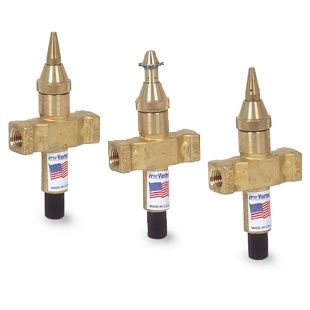
Sprayvector nozzles provide ultra-fine droplet-sized sprays
Sprayvector nozzles provide ultra-fine droplet-sized sprays for evaporative cooling, atomization, humidification and wetting. Superior to conventional hydraulic and piezoelectric nozzles, sprayvectors produce spray patterns that can be widely diffused or directed. The liquid stream is entrained by high velocity compressed air to create a range of micron-level spray droplets, resulting in greater surface coverage than conventional nozzles.
With this more efficient use of the liquid, Sprayvectors accelerate air-liquid interaction to give more effective cooling, humidifying, wetting and dust control.
Three types of Sprayvectors are available, all producing adjustable flow rates from 6 to 30 gallons per hour.
Features
- Produce controlled, ultra-fine droplet sizes
- Removable nozzle tips for easy cleaning and replacement
- Interchangeable nozzle tips give flexibility for fogging, atomizing and humidifying
- Can be used with a wide viscosity range of 1 - 1100 cPs
- Deliver a wide range of liquid flow rates (6 - 30 gallons per hour)
- Require no electrical connection at the nozzle
- Allow low pressure liquid supply (2 - 20 psig)
- Use only 12 scfm of compressed air
- Liquid entrainment using compressed air minimizes clogging
Benefits
- More efficient use of liquid as it is entrained by the compressed air
- Consistent, effective cooling of surfaces reduces heat distortion of parts
- Eliminates damage to wood and other water sensitive surfaces due to low humidity
- Provides even coverage when applying coatings, rust inhibitors, lubricants, preservatives, etc. to parts, wood, rubber, plastic, food, and more
- Reduces noise levels
- Speeds testing for humidity effects due to varying humidity levels
- High pressure liquid flows are not required
- Precision flow rates minimize usage of expensive coatings, preservatives, rust inhibitors, etc.
- Produce finer drops than will hydraulic nozzles
- Droplet size and production is not dependent on liquid pressure
- Air and liquid mix externally to minimize clogging
